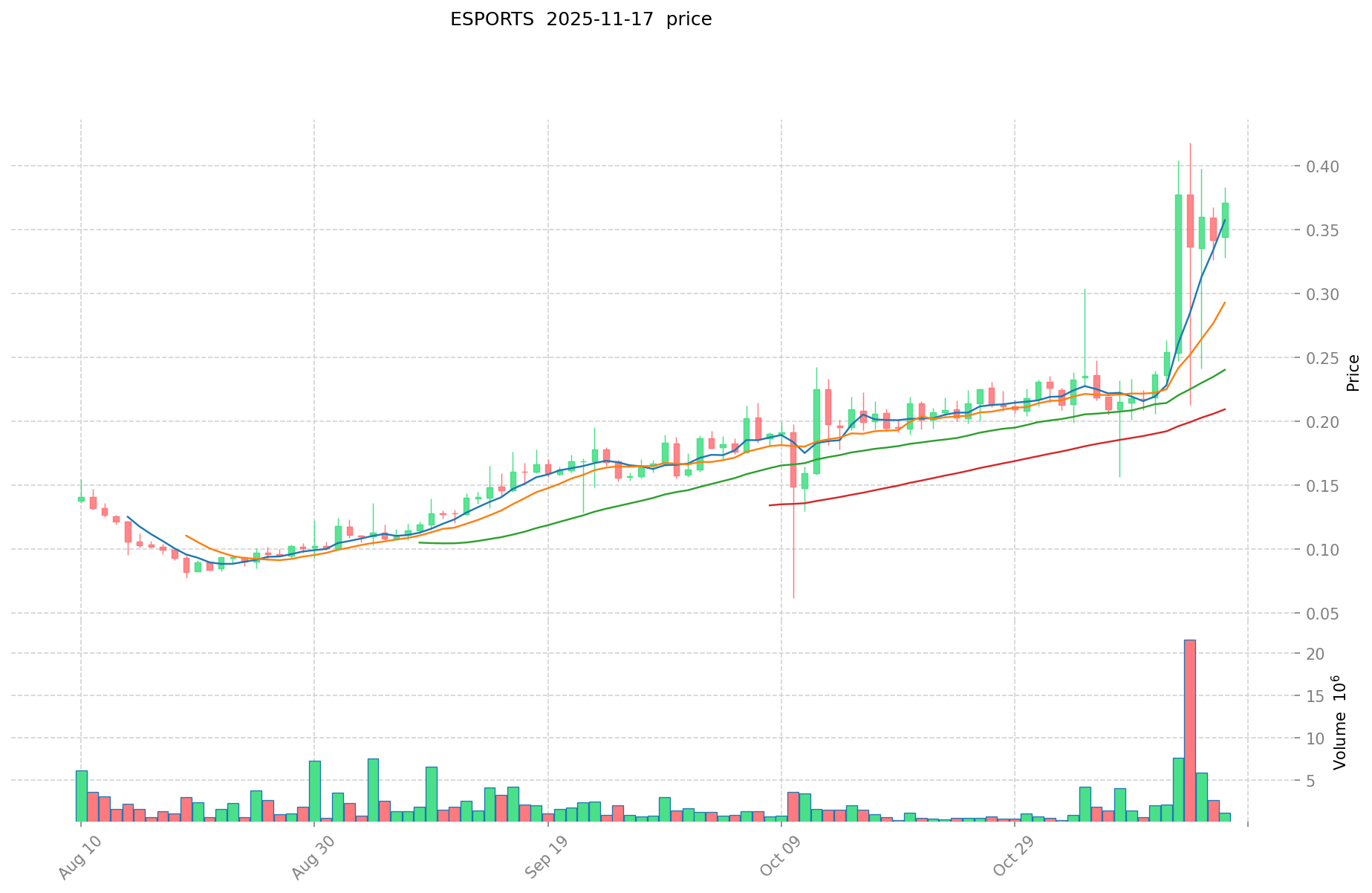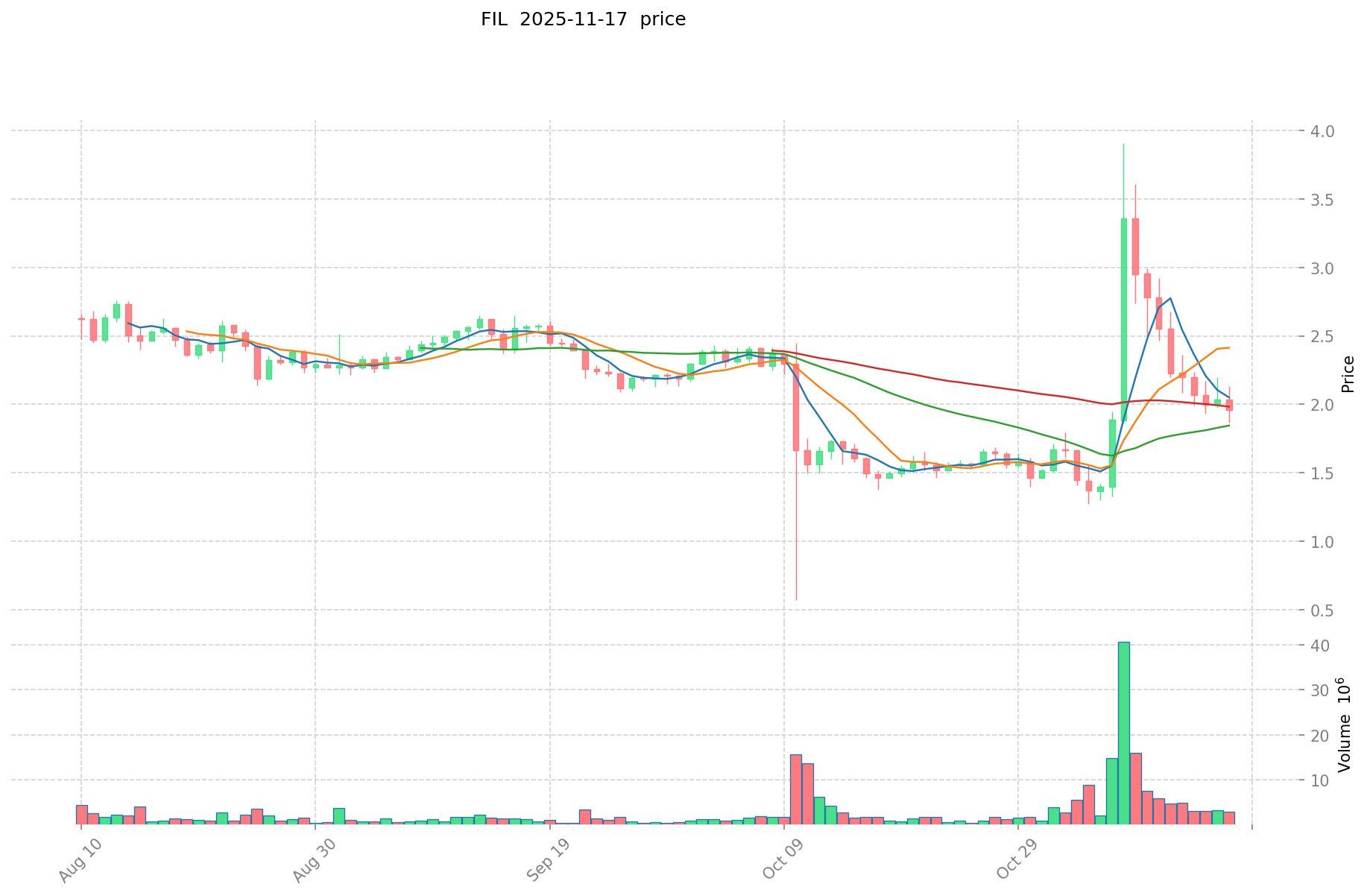ESPORTS vs FIL: The Battle for Digital Dominance in the Gaming World
Introduction: Investment Comparison between ESPORTS and FIL
In the cryptocurrency market, the comparison between ESPORTS vs FIL has always been a topic that investors cannot avoid. The two not only have significant differences in market cap ranking, application scenarios, and price performance, but also represent different cryptocurrency asset positions.
Yooldo Games (ESPORTS): Since its launch in 2021, it has gained market recognition for its multi-chain Web3 gaming platform.
Filecoin(IPFS) (FIL): Since its introduction in 2020, it has been hailed as a decentralized storage network, and is one of the cryptocurrencies with the highest global trading volume and market capitalization.
This article will comprehensively analyze the investment value comparison between ESPORTS vs FIL, focusing on historical price trends, supply mechanisms, institutional adoption, technological ecosystems, and future predictions, and attempt to answer the question that investors care about most:
"Which is the better buy right now?"
I. Price History Comparison and Current Market Status
ESPORTS (Coin A) and FIL (Coin B) Historical Price Trends
- 2025: ESPORTS reached its all-time high of $0.41795 on November 13, 2025.
- 2025: FIL hit its all-time low of $0.848008 on October 11, 2025.
- Comparative Analysis: In recent market cycles, ESPORTS has shown significant growth, rising from its all-time low of $0.002 to its current price of $0.36426, while FIL has experienced a substantial decline from its all-time high of $236.84 to its current price of $1.986.
Current Market Situation (2025-11-17)
- ESPORTS current price: $0.36426
- FIL current price: $1.986
- 24-hour trading volume: ESPORTS $349,176.76 vs FIL $4,629,068.76
- Market Sentiment Index (Fear & Greed Index): 10 (Extreme Fear)
Click to view real-time prices:
- Check ESPORTS current price Market Price
- Check FIL current price Market Price


II. Core Factors Affecting Investment Value of ESPORTS vs FIL
Supply Mechanism Comparison (Tokenomics)
- ESPORTS: Fixed maximum supply of 210 million tokens, following a deflationary model where tokens are burned after being used for tournament entry fees
- FIL: Complex tokenomics with both inflationary (mining rewards) and deflationary (storage provider lock-up) mechanisms, following a halvening schedule approximately every 3 years
- 📌 Historical pattern: FIL's price tends to follow storage mining economics, while ESPORTS shows stronger correlation with tournament participation and ecosystem growth metrics.
Institutional Adoption and Market Applications
- Institutional holdings: FIL has attracted greater institutional investment, particularly from venture capital firms and crypto-focused funds interested in decentralized storage solutions
- Enterprise adoption: FIL has gained traction in enterprise data storage applications, while ESPORTS is primarily utilized within gaming platforms and tournament ecosystems
- National policies: FIL has received positive regulatory attention in regions seeking data sovereignty solutions, while ESPORTS faces varying regulatory classifications depending on jurisdiction
Technical Development and Ecosystem Building
- ESPORTS technical upgrades: Integration with multiple gaming platforms and expansion of tournament capabilities across different game titles
- FIL technical development: Implementation of Filecoin Virtual Machine (FVM), enabling smart contracts and programmable storage solutions
- Ecosystem comparison: FIL has a more developed infrastructure for data storage applications, while ESPORTS has stronger integration with existing esports platforms and gaming communities
Macroeconomic Factors and Market Cycles
- Performance during inflation: FIL potentially offers inflation protection through its utility in providing essential digital infrastructure, while ESPORTS value is more closely tied to gaming industry growth
- Macroeconomic monetary policy: Both tokens show sensitivity to broader crypto market conditions, though FIL demonstrates higher correlation with technology sector performance
- Geopolitical factors: FIL benefits from increasing data localization requirements globally, while ESPORTS growth depends more on regional gaming market development and tournament infrastructure
III. 2025-2030 Price Prediction: ESPORTS vs FIL
Short-term Prediction (2025)
- ESPORTS: Conservative $0.3203 - $0.3640 | Optimistic $0.3640 - $0.4660
- FIL: Conservative $1.9332 - $1.9930 | Optimistic $1.9930 - $2.3318
Mid-term Prediction (2027)
- ESPORTS may enter a growth phase, with an estimated price range of $0.3617 - $0.5993
- FIL may enter a consolidation phase, with an estimated price range of $1.1852 - $2.9630
- Key drivers: Institutional capital inflow, ETF developments, ecosystem growth
Long-term Prediction (2030)
- ESPORTS: Base scenario $0.7322 - $0.9006 | Optimistic scenario $0.9006 - $1.0000
- FIL: Base scenario $3.6936 - $4.6539 | Optimistic scenario $4.6539 - $5.0000
Disclaimer: The above predictions are based on historical data and market analysis. Cryptocurrency markets are highly volatile and subject to rapid changes. This information should not be considered as financial advice. Always conduct your own research before making investment decisions.
ESPORTS:
| 年份 | 预测最高价 | 预测平均价格 | 预测最低价 | 涨跌幅 |
|---|---|---|---|---|
| 2025 | 0.4659584 | 0.36403 | 0.3203464 | 0 |
| 2026 | 0.618341358 | 0.4149942 | 0.402544374 | 13 |
| 2027 | 0.59933462364 | 0.516667779 | 0.3616674453 | 41 |
| 2028 | 0.6472813935312 | 0.55800120132 | 0.4910410571616 | 53 |
| 2029 | 0.861777055318608 | 0.6026412974256 | 0.470060211991968 | 65 |
| 2030 | 0.900617286937687 | 0.732209176372104 | 0.446647597586983 | 101 |
FIL:
| 年份 | 预测最高价 | 预测平均价格 | 预测最低价 | 涨跌幅 |
|---|---|---|---|---|
| 2025 | 2.33181 | 1.993 | 1.93321 | 0 |
| 2026 | 2.22727715 | 2.162405 | 1.6434278 | 9 |
| 2027 | 2.96303545125 | 2.194841075 | 1.1852141805 | 10 |
| 2028 | 3.37840912469375 | 2.578938263125 | 1.8052567841875 | 30 |
| 2029 | 4.408437066985875 | 2.978673693909375 | 2.740379798396625 | 50 |
| 2030 | 4.653879779364007 | 3.693555380447625 | 2.991779858162576 | 86 |
IV. Investment Strategy Comparison: ESPORTS vs FIL
Long-term vs Short-term Investment Strategy
- ESPORTS: Suitable for investors focused on gaming industry growth and ecosystem potential
- FIL: Suitable for investors seeking exposure to decentralized storage solutions and data sovereignty trends
Risk Management and Asset Allocation
- Conservative investors: ESPORTS: 20% vs FIL: 80%
- Aggressive investors: ESPORTS: 60% vs FIL: 40%
- Hedging tools: Stablecoin allocation, options, cross-currency portfolios
V. Potential Risk Comparison
Market Risk
- ESPORTS: Highly dependent on gaming industry trends and tournament participation
- FIL: Vulnerable to competition from centralized cloud storage providers and other blockchain storage solutions
Technical Risk
- ESPORTS: Scalability, network stability during peak tournament periods
- FIL: Mining power concentration, potential security vulnerabilities in smart contract implementation
Regulatory Risk
- Global regulatory policies may have differing impacts on gaming tokens and utility tokens for decentralized storage
VI. Conclusion: Which Is the Better Buy?
📌 Investment Value Summary:
- ESPORTS advantages: Strong growth potential in the expanding esports market, deflationary tokenomics
- FIL advantages: Established position in decentralized storage, institutional adoption, potential for enterprise use cases
✅ Investment Advice:
- New investors: Consider a balanced approach with a slight bias towards FIL due to its more established market position
- Experienced investors: Explore opportunities in ESPORTS for higher growth potential, while maintaining exposure to FIL
- Institutional investors: Evaluate FIL for its utility in decentralized storage solutions, while monitoring ESPORTS for potential disruption in the gaming industry
⚠️ Risk Warning: The cryptocurrency market is highly volatile, and this article does not constitute investment advice. None
VII. FAQ
Q1: What are the key differences between ESPORTS and FIL in terms of their use cases? A: ESPORTS is primarily focused on the gaming and esports industry, used for tournament entry fees and ecosystem participation. FIL, on the other hand, is designed for decentralized data storage solutions and has broader applications in enterprise and data sovereignty contexts.
Q2: How do the supply mechanisms of ESPORTS and FIL compare? A: ESPORTS has a fixed maximum supply of 210 million tokens with a deflationary model, where tokens are burned after use. FIL has a more complex tokenomics system with both inflationary (mining rewards) and deflationary (storage provider lock-up) mechanisms, following a halvening schedule.
Q3: Which token has shown better price performance in recent market cycles? A: In recent market cycles, ESPORTS has shown significant growth, rising from its all-time low of $0.002 to its current price of $0.36426. FIL, however, has experienced a substantial decline from its all-time high of $236.84 to its current price of $1.986.
Q4: How does institutional adoption compare between ESPORTS and FIL? A: FIL has attracted greater institutional investment, particularly from venture capital firms and crypto-focused funds interested in decentralized storage solutions. ESPORTS, while growing, has less institutional adoption and is primarily utilized within gaming platforms and tournament ecosystems.
Q5: What are the long-term price predictions for ESPORTS and FIL by 2030? A: For ESPORTS, the base scenario predicts a range of $0.7322 - $0.9006, with an optimistic scenario of $0.9006 - $1.0000. For FIL, the base scenario predicts a range of $3.6936 - $4.6539, with an optimistic scenario of $4.6539 - $5.0000.
Q6: How should investors allocate their portfolio between ESPORTS and FIL? A: Conservative investors might consider allocating 20% to ESPORTS and 80% to FIL, while aggressive investors might opt for 60% ESPORTS and 40% FIL. The specific allocation should be based on individual risk tolerance and investment goals.
Q7: What are the main risks associated with investing in ESPORTS and FIL? A: For ESPORTS, key risks include dependence on gaming industry trends and potential scalability issues. For FIL, risks include competition from centralized cloud storage providers and potential mining power concentration. Both face regulatory risks, which may vary depending on global policies towards gaming tokens and utility tokens for decentralized storage.
Share
Content